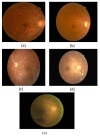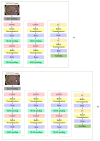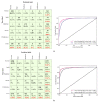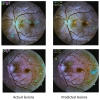Diabetic Retinopathy Fundus Image Classification and Lesions Localization System Using Deep Learning
- PMID: 34073541
- PMCID: PMC8198489
- DOI: 10.3390/s21113704
Diabetic Retinopathy Fundus Image Classification and Lesions Localization System Using Deep Learning
Abstract
Diabetic retinopathy (DR) is a disease resulting from diabetes complications, causing non-reversible damage to retina blood vessels. DR is a leading cause of blindness if not detected early. The currently available DR treatments are limited to stopping or delaying the deterioration of sight, highlighting the importance of regular scanning using high-efficiency computer-based systems to diagnose cases early. The current work presented fully automatic diagnosis systems that exceed manual techniques to avoid misdiagnosis, reducing time, effort and cost. The proposed system classifies DR images into five stages-no-DR, mild, moderate, severe and proliferative DR-as well as localizing the affected lesions on retain surface. The system comprises two deep learning-based models. The first model (CNN512) used the whole image as an input to the CNN model to classify it into one of the five DR stages. It achieved an accuracy of 88.6% and 84.1% on the DDR and the APTOS Kaggle 2019 public datasets, respectively, compared to the state-of-the-art results. Simultaneously, the second model used an adopted YOLOv3 model to detect and localize the DR lesions, achieving a 0.216 mAP in lesion localization on the DDR dataset, which improves the current state-of-the-art results. Finally, both of the proposed structures, CNN512 and YOLOv3, were fused to classify DR images and localize DR lesions, obtaining an accuracy of 89% with 89% sensitivity, 97.3 specificity and that exceeds the current state-of-the-art results.
Keywords: YOLO; computer-aided diagnosis; convolutional neural networks; deep learning; diabetic retinopathy; diabetic retinopathy classification; diabetic retinopathy lesions localization.
Conflict of interest statement
The authors declare no conflict of interest.
Figures















Similar articles
-
Simple methods for the lesion detection and severity grading of diabetic retinopathy by image processing and transfer learning.Comput Biol Med. 2021 Oct;137:104795. doi: 10.1016/j.compbiomed.2021.104795. Epub 2021 Aug 25. Comput Biol Med. 2021. PMID: 34488028
-
Attention-based deep learning framework for automatic fundus image processing to aid in diabetic retinopathy grading.Comput Methods Programs Biomed. 2024 Jun;249:108160. doi: 10.1016/j.cmpb.2024.108160. Epub 2024 Apr 3. Comput Methods Programs Biomed. 2024. PMID: 38583290
-
A computer-aided diagnosis system for detecting various diabetic retinopathy grades based on a hybrid deep learning technique.Med Biol Eng Comput. 2022 Jul;60(7):2015-2038. doi: 10.1007/s11517-022-02564-6. Epub 2022 May 11. Med Biol Eng Comput. 2022. PMID: 35545738 Free PMC article.
-
Deep learning based computer-aided diagnosis systems for diabetic retinopathy: A survey.Artif Intell Med. 2019 Aug;99:101701. doi: 10.1016/j.artmed.2019.07.009. Epub 2019 Aug 7. Artif Intell Med. 2019. PMID: 31606116 Review.
-
Deep learning for diabetic retinopathy detection and classification based on fundus images: A review.Comput Biol Med. 2021 Aug;135:104599. doi: 10.1016/j.compbiomed.2021.104599. Epub 2021 Jun 25. Comput Biol Med. 2021. PMID: 34247130 Review.
Cited by
-
Diabetic retinopathy detection using Bilayered Neural Network classification model with resubstitution validation.MethodsX. 2024 Apr 6;12:102705. doi: 10.1016/j.mex.2024.102705. eCollection 2024 Jun. MethodsX. 2024. PMID: 38633420 Free PMC article.
-
Artificial intelligence in chorioretinal pathology through fundoscopy: a comprehensive review.Int J Retina Vitreous. 2024 Apr 23;10(1):36. doi: 10.1186/s40942-024-00554-4. Int J Retina Vitreous. 2024. PMID: 38654344 Free PMC article. Review.
-
Performance and limitation of machine learning algorithms for diabetic retinopathy screening and its application in health management: a meta-analysis.Biomed Eng Online. 2025 Mar 14;24(1):34. doi: 10.1186/s12938-025-01336-1. Biomed Eng Online. 2025. PMID: 40087776 Free PMC article.
-
Deep Learning for Diabetic Retinopathy Analysis: A Review, Research Challenges, and Future Directions.Sensors (Basel). 2022 Sep 8;22(18):6780. doi: 10.3390/s22186780. Sensors (Basel). 2022. PMID: 36146130 Free PMC article. Review.
-
Hybrid model of feature-driven modular neural network-based grasshopper optimization algorithm for diabetic retinopathy classification using fundus images.Med Biol Eng Comput. 2025 Aug;63(8):2423-2436. doi: 10.1007/s11517-025-03307-z. Epub 2025 Mar 6. Med Biol Eng Comput. 2025. PMID: 40048106
References
-
- American Academy of Ophthalmology-What Is Diabetic Retinopathy. [(accessed on 1 January 2019)]; Available online: https://www.aao.org/eye-health/diseases/what-is-diabetic-retinopathy.
-
- Taylor R., Batey D. Handbook of Retinal Screening in Diabetes: Diagnosis and Management. 2nd ed. John Wiley & Sons, Ltd., Wiley-Blackwell; Hoboken, NJ, USA: 2012. pp. 1–173. - DOI
-
- Wilkinson C.P., Ferris F.L., Klein R.E., Lee P.P., Agardh C.D., Davis M., Dills D., Kampik A., Pararajasegaram R., Verdaguer J.T., et al. Proposed international clinical diabetic retinopathy and diabetic macular edema disease severity scales. Am. Acad. Ophthalmol. 2003;110:1677–1682. doi: 10.1016/S0161-6420(03)00475-5. - DOI - PubMed
-
- Deng L., Yu D. Deep learning: Methods and applications. Found. Trends Signal Process. 2014;7:197–387. doi: 10.1561/2000000039. - DOI
MeSH terms
LinkOut - more resources
Full Text Sources
Medical

